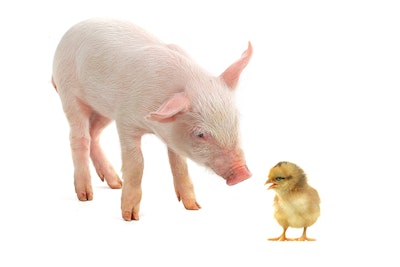
The pork and poultry supply chains faced unprecedented strain during the peak of the COVID-19 pandemic. What did these two industries learn from COVID-19?
“Increasing worker health protections, self-quarantine payments, slowing line speeds, diverting foodservice product to retail, and culling surplus live animals have all been required. Going forward, reducing sow and broiler breeder numbers may be required,” said Dr. Thomas Elam, Ph.D., President, FarmEcon.
Elam, alongside Dr. Carl Heeder, DVM, Senior Director of Avian Health and Nutrition, Mountaire Farms and Dr. Steve Kitt, Ph.D., Nutrition and Production Consultant, First Choice Livestock, will share strategies to address challenges brought on by COVID-19 during a webinar on Tuesday, July 28 at 9:00 a.m. CDT.
Free registration for “COVID-19 monogastric roundtable: Where do we go from here?” is now open. The webinar is proudly sponsored by Kerry Animal Performance Solutions and presented by WATTAgNet, Feed Strategy and WATT Global Media.
More to come
A recent surge in COVID-19 cases could slow recovery for both markets.
“The unknown and the continuous evolution of the issues was the biggest challenge. We would go home at night worrying about one issue, get faced with a different issue the next morning, and it could change during the course of the day," Heeder said.
"Communication was critical thru this crisis. Sharing innovative solutions to new requirements or problems across our company was so important. There were so many things early on in the crisis we thought would be impossible were quickly resolved and executed daily."
Looking forward
The pig and poultry industries will need to take time to assess what worked during COVID-19 and what didn’t. These lessons could help with future challenges.
“We’ll to need to learn what we didn’t know before COVID-19. Can we use some of these techniques for future applications?” Kitt said.
Regardless of the challenges that lie ahead, the U.S. protein markets has worked hard to keep the supply chain strong, ensuring that consumers are able to find the products they need.
“U.S. protein production has held up remarkably in the face of challenges not seen in 80 years. Despite unprecedented challenges grocery stores are well stocked. Even with toilet paper. Give American ingenuity a little time and freedom to act and we can accomplish miracles,” said Elam.
View our continuing coverage of the coronavirus/COVID-19 pandemic.


















